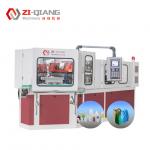Controllable Energy Consumption and Good Mold Compatibility with IBM Injection Blow Molding Machine
|
|
A. High degree of automation: Automatic feeding, molding, demoulding and other processes can be realized, reducing manual intervention. • Stable production cycle: The processes are closely connected, and the single-mold production time fluctuates little, which is conducive to stable batch production. • High product precision: The parameters such as bottle mouth size and wall thickness are precisely controlled, and the error can be controlled within a small range. • Suitable for aseptic production: Easy to integrate clean systems to meet the aseptic requirements of the pharmaceutical, food and other industries. • Less post-processing: One-time molding reduces trimming and other processes, saving manpower and time costs. B. Relatively controllable energy consumption: The integrated
design reduces the energy loss of material transfer between
processes, and precise control of parameters can avoid energy
waste. |

|
Injection Blow Molding Machine with 100 KN Clamping Force and Low Energy Consumption |

|
Synchronized Bottle electric injection molding machine for 45/50mm Screw Diameter |

|
Full Servo Drive AI Control Plastic Bottle Molding Machine For Precision Manufacturing Of Cosmetic Bottles |

|
ZQ60 Injection-Blow Molding Machine: Efficient Mass-Production Equipment with European Design |

|
Easy to Operate HDPE Bottle Blowing Machine for Mould Bottle height 220mm Production |

|
ZQ80 Injection-Blow Molding Machine: An Efficient and Energy-Saving European-Style Precision Equipment |





